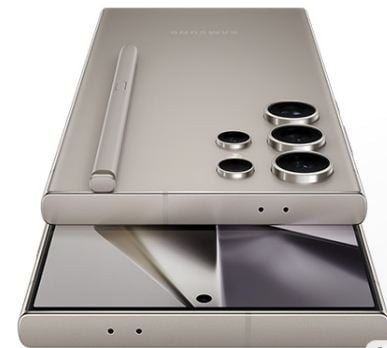Elevate your artistic skills with our comprehensive guide to easy doodling mandala art. Whether you’re a beginner or seasoned artist, our step-by-step techniques will empower you to create intricate mandala and doodle designs effortlessly. Explore the therapeutic benefits of doodling as you immerse yourself in a world of creativity and relaxation. Start your mandala journey today and unlock the secrets to crafting stunning artwork with ease.
Curious about what is DoodleArt ? Explore the whimsical world where simple lines transform into intricate designs and imaginative creations. Discover the essence of doodle art, its origins, techniques, and how it inspires creativity. Whether you’re a beginner or a seasoned artist, unravel the mysteries behind this expressive form of art and unleash your inner doodler.”
Table of Contents
Introduction: What is Doodle Art ?
The term “doodle” has been used since the early 20th century and refers to the act of drawing or scribbling without purpose. But scrawling random words, squiggly lines, and little pictures is a much older habit, and its occurrence in books reveals a lot about how people once interacted with literature.
Doodle art is a form of spontaneous drawing that can be done by anyone, regardless of their artistic skill level. It involves creating simple drawings, often unconsciously, while the mind is occupied with other tasks. These drawings can range from abstract patterns to intricate designs and are typically made using pen or pencil on paper.
Getting Started with Doodle Art
Before diving into DoodleArt, it’s essential to gather the necessary supplies. A sheet of paper and a pen or pencil will do. You can also experiment with different types of pens, such as fine liners or gel pens, to achieve varying line thicknesses and effects.
Once you have your supplies, find a comfortable workspace where you can relax and let your creativity flow. Eliminate any distractions and make sure you have plenty of space to spread out your materials.
Easy Doodle Art Ideas for Beginners
If you’re new to doodle art, Easy Doodle Art can be helpful to start with simple ideas and gradually work your way up to more complex designs. Here are a few easy doodle art ideas to get you started:
Simple Shapes and Patterns:
When it comes to simple shapes and patterns, think of it like doodling 101. You start with the basics—circles, squares, and triangles. Just draw them however you like, there’s no right or wrong way. Then comes the fun part: filling them in with cool patterns. Think stripes, dots, zigzags, or even little squiggles. It’s like decorating your own mini universe on paper! So grab your pen, let your imagination run wild, and see where your doodle journey takes you. Who knows, maybe you’ll find your new hobby.
Nature-Inspired Doodles:
Nature-inspired doodles are like bringing a little piece of the outdoors onto your paper canvas. Imagine doodling flowers blooming, leaves dancing in the wind, or cute little animals peeking out from behind bushes. Nature gives us endless inspiration, so why not capture its beauty in your doodles? Whether you’re drawing a delicate petal or a playful squirrel, let your imagination run wild with the wonders of nature. So next time you’re out for a walk or gazing out your window, take a moment to soak in the beauty around you—and
then bring it to life with your doodle pen..
Easy Doodling Mandala Art
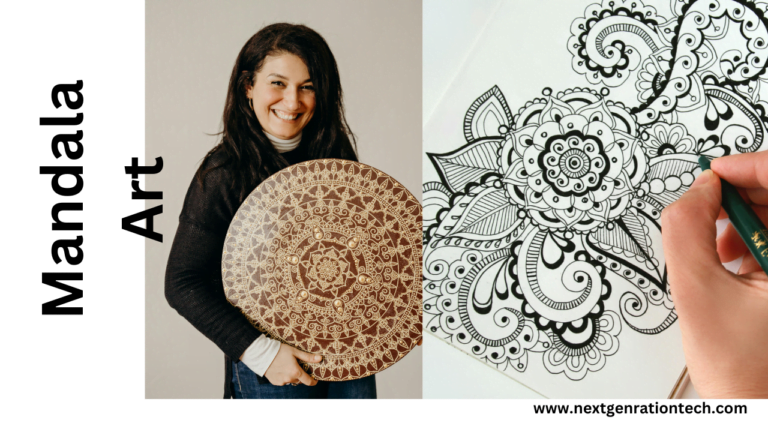
Creating easy mandala art through doodling is a delightful way to explore your creativity. Mandala, a Sanskrit word meaning “circle,” is a symbol of unity, wholeness, and harmony. With doodling, you can make simple mandalas using repetitive patterns and shapes. Start with a central point, then draw circles or other geometric shapes around it. Fill these shapes with easy patterns like dots, lines, or curves. As you add layers, your mandala will evolve into a mesmerizing design. The beauty of easy mandala art doodle lies in their simplicity and the meditative process of creation. So grab your pen and paper, and let your imagination flow as you create your own unique mandala art.
Doodle Mandala Art :
Doodle mandalas arts are like creating your own little universe of peace and symmetry on paper. Picture intricate designs made up of repeating patterns and circles within circles, each layer adding a new dimension of beauty. Mandalas have been used for centuries in various cultures as a form of meditation and spiritual expression. But you don’t need to be a monk to enjoy them just grab your pen and start drawing from the center outwards, letting the patterns flow naturally. It’s a calming and mesmerizing experience, like getting lost in a labyrinth of creativity. Easy doodling mandala art of your own—it’s like art therapy for the soul.
Doodle Art Techniques
While doodle art is known for its spontaneity, there are still some techniques you can use to enhance your drawings:
Experiment with Line Variations: Try using different pen thicknesses and styles to add depth and interest to your doodles. Thick lines can create bold outlines, while thin lines can add delicate details.
Play with Shading and Hatching: Use shading techniques like cross-hatching or stippling to fill in areas of your doodles and create dimension. Lightly shading areas can add depth and contrast to your drawings.
Add Texture with Patterns: Incorporate patterns like dots, dashes, or squiggles into your doodles to add texture and visual interest. These patterns can be used to fill in empty spaces or to create unique effects.
Explore Negative Space: Don’t be afraid to leave some areas of your doodles blank to create contrast and visual balance. Negative space can add depth and emphasis to certain parts of your drawings.
Incorporate Color: While traditional doodles are often done in black and white, don’t hesitate to add color to your drawings. Experiment with colored pens, markers, or even watercolors to bring your doodles to life.
Practice Patience and Precision: Take your time with each doodle, focusing on precision and attention to detail. The more patience you have, the more intricate and polished your doodles will become.
Embrace Imperfection: Remember that doodle art is all about having fun and expressing yourself. Don’t worry about making mistakes—embrace them as part of the creative process and learn from them.
Seek Inspiration: Look for inspiration in everyday objects, patterns, or your surroundings. Take note of interesting shapes, textures, and designs that you can incorporate into your doodles.
Experiment and Explore: Don’t be afraid to try new techniques and styles in your doodles. The more you experiment and explore, the more you’ll grow as an artist and discover your unique doodle style.
Share and Connect: Share your doodles with others and connect with fellow doodle enthusiasts. Join online communities or attend doodle workshops to learn from others and exchange ideas.
Reflect and Learn: Take time to reflect on your doodles and consider what worked well and what you could improve upon. Learning from your experiences will help you continue to grow and develop as a doodle artist.
Line Variations: Experiment with different line weights and styles to add
interest to your doodles.
Filling Techniques: Practice shading and hatching to fill in larger areas of your doodles and create depth.
Adding Texture and Depth: Use techniques like stippling or cross-hatching to add texture and dimension to your drawings.
Overcoming Doodle Art Challenges :
Like any form of art, doodle art comes with its own set of challenges. Here are a few common obstacles you may encounter and how to overcome them. By addressing these below mentioned challenges with practical solutions and examples, you can overcome obstacles and enjoy the doodling process with confidence and creativity.
Blank Page Syndrome:
- Description: Blank page syndrome occurs when you feel stuck and overwhelmed by the emptiness of the paper in front of you.
- Example: You sit down to doodle, but your mind draws a blank, and you’re not sure where to start.
- Solution: Start by making small marks or doodles on the page to break the ice. Even a single dot or squiggle can kickstart your creativity and get the ideas flowing.
Perfectionism :
- Description: Perfectionism is the desire to make every doodle flawless, leading to frustration and fear of making mistakes.
- Example: You spend hours trying to create the perfect doodle, erasing and redoing lines repeatedly.
- Solution: Embrace imperfection and view mistakes as opportunities for growth. Remember that doodle art is all about spontaneity and self-expression, so allow yourself to let go of the need for perfection.
Lack of Inspiration :
- Description: Lack of inspiration occurs when you struggle to come up with ideas or themes for your doodles.
- Example: You’re sitting at your desk, staring at a blank page, but nothing seems to inspire you.
- Solution: Look for inspiration in your surroundings, such as nature, everyday objects, or even your emotions. Take a walk outside, browse through art books or websites, or listen to music to spark your creativity.
Time Constraints :
- Description: Time constraints occur when you feel pressured to create doodles within a limited timeframe.
- Example: You have a busy schedule and only a few minutes to spare for doodling each day.
- Solution: Make doodling a part of your daily routine, even if it’s just for a few minutes. Set realistic goals for yourself and focus on enjoying the process rather than worrying about the outcome.
Comparison with Others :
- Description: Comparison with others occurs when you measure your doodles against those of more experienced artists, leading to self-doubt and discouragement.
- Example: You scroll through social media and feel envious of the elaborate doodles posted by professional artists.
- Solution: Remember that everyone starts somewhere, and improvement takes time and practice. Instead of comparing yourself to others, focus on your own progress and celebrate your unique style and creativity.
- Description: Art block is a creative rut where you struggle to come up with new ideas or feel uninspired to doodle.
- Example: You’ve been doodling for days, but suddenly, you hit a wall, and no ideas seem to flow.
Solution: Take a break and engage in activities that rejuvenate your creativity, such as going for a walk, reading a book, or trying a new hobby. Sometimes, stepping away from doodling for a while can help you come back with fresh perspectives and ideas.
You may also like:
What is Art Block, Artist Block & How to Get Rid of Art Block?
सफलता की कुंजी “Fashion Designer Kaise Bane”
Fine Arts –What Is It All About?
Distractions :
- Description: Distractions are external factors that disrupt your focus and hinder your doodling process.
- Example: You’re trying to doodle, but your phone keeps buzzing with notifications, or there’s noise and chaos around you.
- Solution: Create a dedicated doodling space free from distractions, turn off notifications, and set aside specific times for doodling when you can focus without interruptions.
Fear of Failure :
- Description: Fear of failure is the fear of making mistakes or producing subpar doodles, leading to self-doubt and hesitation.
- Example: You avoid doodling altogether because you’re afraid of not meeting your own expectations.
- Solution: Embrace the mindset of experimentation and learning. Remember that every doodle, regardless of its outcome, is an opportunity to learn and grow as an artist. Don’t let the fear of failure hold you back from expressing yourself through doodle art.
Exploring Creative Doodle Art :
Once you’ve mastered the basics of doodle art, the possibilities are endless. Here are a few creative ideas to take your doodles to the next level. By exploring these creative avenues in doodle art, you can unleash your imagination, express yourself, and discover new ways to bring your doodles to life. Whether you’re inspired by music, culture, nature, or fantasy, there’s a world of possibilities waiting to be explored through doodle art.
Music-Inspired Doodles :
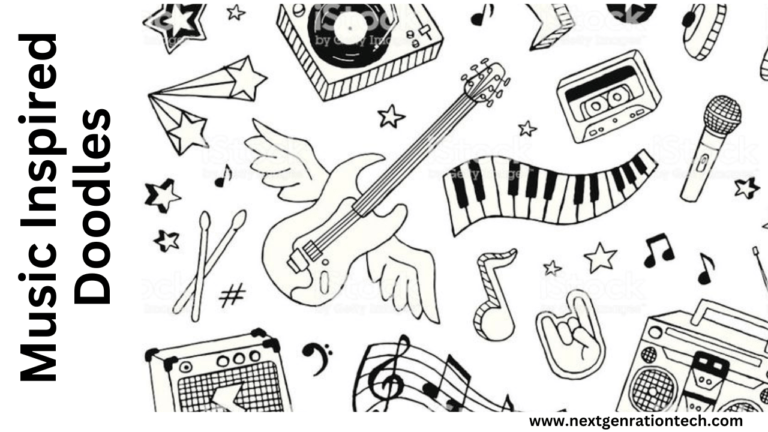
- Description: Music-inspired doodles or music doodle art are created while listening to music, allowing the rhythm and emotions of the music to influence the doodle’s style and themes.
- Example: As you listen to a lively jazz tune, you might doodle swirling lines and dynamic shapes that mirror the upbeat tempo of the music. Alternatively, a calming classical piece might inspire delicate and intricate patterns reminiscent of classical compositions.
Anime-Inspired Doodles:
- Description: Anime-inspired doodles or anime doodle art are influenced by the distinctive style of Japanese animation, featuring characters with exaggerated expressions and vibrant personalities.
- Example: You might doodle your favorite anime characters in your own unique style or create original characters inspired by the aesthetics of anime. Think big eyes, spiky hair, and expressive gestures that capture the essence of anime.
Indian Doodle Art Styles :
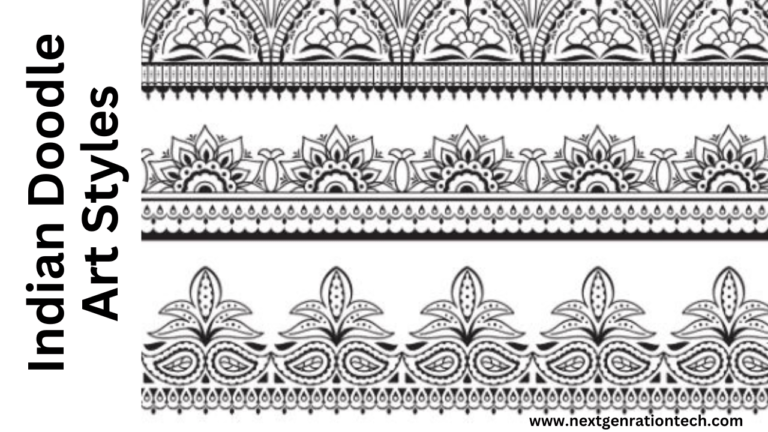
- Description: Indian doodle art styles draw inspiration from traditional Indian motifs, patterns, and cultural symbols, resulting in rich and intricate designs that reflect the country’s diverse heritage.
- Example: You could incorporate elements of traditional Indian art forms such as Madhubani or Warli into your doodles, using intricate patterns, geometric shapes, and symbolic motifs like peacocks, lotus flowers, or elephants. These doodles celebrate India’s vibrant culture and artistic traditions.
Nature-Inspired Doodles :
- Description: Nature-inspired doodles draw inspiration from the natural world, featuring elements like flowers, leaves, animals, and landscapes.
- Example: You might doodle a lush forest scene complete with towering trees, chirping birds, and a babbling brook, or focus on individual elements like intricate floral patterns or whimsical animal characters. Nature-inspired doodles offer endless possibilities for creativity and exploration.
Fantasy and Sci-Fi Doodles:
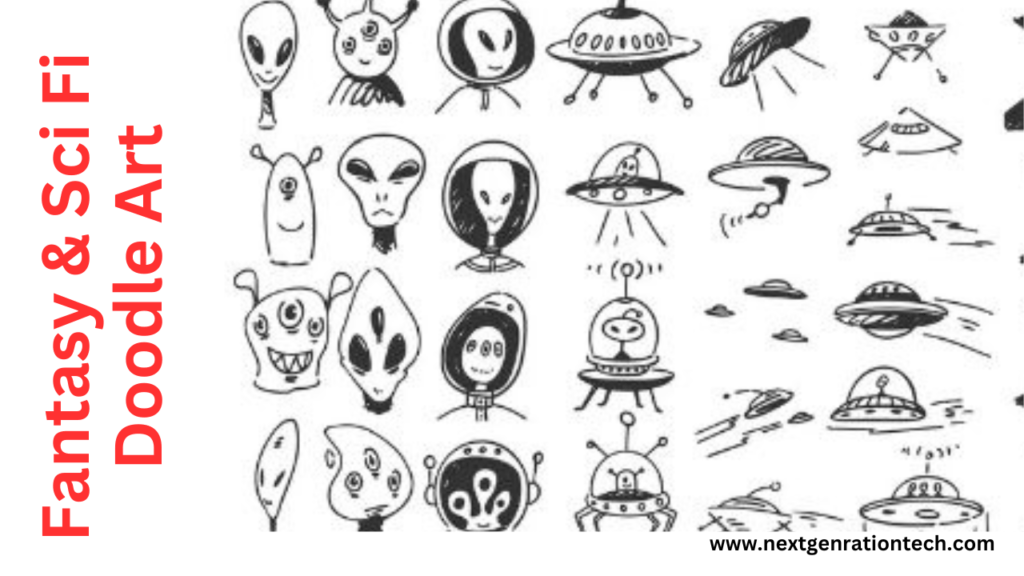
- Description: Fantasy and sci-fi doodles transport viewers to imaginary worlds filled with fantastical creatures, futuristic technology, and epic adventures.
- Example: Let your imagination run wild as you doodle mythical creatures like dragons, unicorns, and mermaids, or envision futuristic cities, space stations, and alien landscapes. These doodles allow you to escape reality and explore the realms of imagination.
Storytelling Through Doodles:
- Description: Doodles can be used to tell stories and convey emotions, capturing moments in time or illustrating narrative sequences.
- Example: You might create a series of doodles that depict a character’s journey from ordinary life to extraordinary adventures, using visual storytelling techniques to evoke suspense, excitement, or humor. Each doodle becomes a snapshot of a larger narrative, inviting viewers to imagine the story behind the images.
Interactive and Collaborative Doodles:
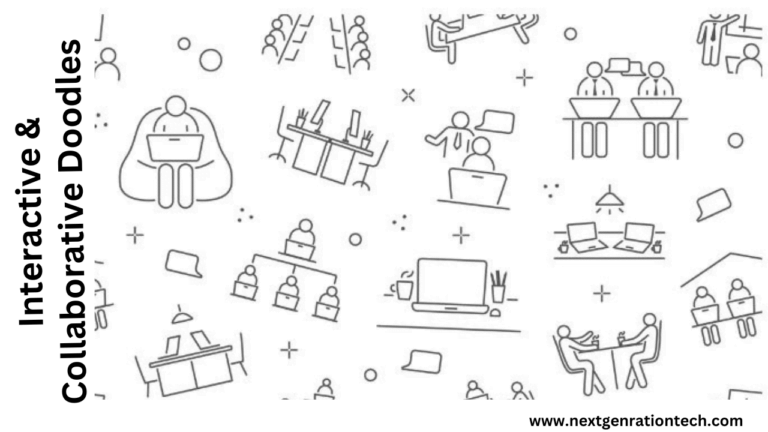
- Description: Interactive and collaborative doodles invite participation from viewers, encouraging them to add their own creative touches to the artwork.
- Example: You could create a large-scale doodle on a communal canvas or digital platform and invite others to contribute their own doodles, creating a collaborative artwork that reflects the collective creativity of the participants. This interactive approach fosters community engagement and fosters a sense of connection among doodle enthusiasts.
Experimental Doodle Techniques:
- Description: Experimental doodle techniques involve pushing the boundaries of traditional doodle art by exploring unconventional materials, processes, and styles.
- Example: You might experiment with mixed media doodles, combining pen and ink with watercolor, collage, or digital effects to create unique textures and visual effects. Alternatively, you could explore abstract doodle art, focusing on expressive gestures, spontaneous mark-making, and intuitive compositions that defy conventional representation.
50 Important Terminology Used in Doodle/ Doodling:
- Doodling Meaning: Doodling refers to the act of drawing aimlessly or absentmindedly, often in a repetitive or spontaneous manner. It can range from simple shapes and patterns to more elaborate drawings.
- Doodling in Art: In art, doodling can be considered a form of creative expression. Some artists intentionally incorporate doodle-like elements into their work, either as standalone pieces or as part of larger compositions.
- Sketching Doodling: Sketching doodling involves creating spontaneous drawings, often characterized by quick and loose strokes. It can be a way for artists to explore ideas or simply to relax and unwind.
- DoodleArt Girl:Doodle art girls are a popular subject for both aspiring and experienced doodlers. There are endless possibilities when it comes to creating a doodle art girl, and the beauty of this art form is that there are no wrong answers. Fashionable Doodlers:Doodle a girl striking a pose in a fancy ballgown or a casual sundress. You can add details like ruffles, flowers, or buttons to make the outfit pop.Hair Flair:Doodle a girl with elaborate braids, voluminous curls, or a spunky pixie cut. Let your imagination run wild with different hairstyles and hair accessories.Action Doodlers:Capture a girl in motion, like skateboarding, dancing, or playing a sport. This can add a sense of energy and dynamism to your doodle.Emotional Doodlers:Use doodles to express a girl’s emotions. This could be happiness (with a big smile and sunshine), sadness (with teardrops and droopy features), or excitement (with wide eyes and stars).Portraits:Doodle a girl’s face, focusing on details like her eyes, nose, and mouth. You can add glasses, hats, or other accessories to personalize your doodle.
- Creative Doodle Art: Creative doodle art involves using doodling techniques to produce visually interesting and engaging artwork. This can include combining different shapes, patterns, and colors to create unique compositions.
- Doodle Art Sketch: A doodle art sketch is a drawing created using doodling techniques. It may feature a variety of elements, such as lines, shapes, and patterns, arranged in a creative and visually appealing manner.
- Health Doodle: Health Doodling can have positive effects on mental well-being, promoting relaxation and mindfulness. It can also improve focus and concentration by engaging the brain in a low-pressure activity.
- Body Doodlers: Body doodlers are individuals who incorporate doodle-like designs or patterns into body art, such as tattoos or body painting. These designs can range from simple to intricate and are often used for self-expression.
- Doodle Line Art: Doodle line art refers to drawings or designs created primarily using lines. It focuses on minimalist approaches to doodling, using lines to create shapes, patterns, and textures.
- Line ArtDoodles: Line art doodles are similar to doodle line art but may involve more intricate and detailed designs. They often feature a combination of lines, shapes, and patterns to create visually striking compositions.
- Doodle Shapes: Doodle shapes encompass the various forms and patterns that can be created through doodling. These shapes can range from simple geometric figures to complex and abstract designs.
- Doodling Techniques: Doodling techniques vary widely and can include freeform drawing, repetitive patterns, shading, and experimenting with different mediums such as pens, pencils, markers, or digital tools.
- Digital Doodling: With the advent of digital technology, doodling has expanded into the digital realm. Digital doodling allows artists to create using software or apps, offering a wide range of tools and effects for experimentation.
- Doodle Therapy: Doodling can serve as a form of Doodle therapy, providing a creative outlet for expressing emotions, reducing anxiety, and improving overall mental well-being. Some therapists incorporate doodling into their practices as a therapeutic tool.
- Educational Doodling: Doodling is not just for art; it can also enhance learning and retention. Many people find that doodling while listening or studying helps them focus and better understand complex concepts.
- Community Doodling: Doodling can also be a communal activity, bringing people together to collaborate on large-scale doodle murals or participate in doodle challenges and events, fostering creativity and connection.
- Professional Doodlers: Some artists specialize in doodle art professionally, creating illustrations, designs, and commissioned artwork that incorporate doodle-style They often showcase their work through exhibitions, social media, and online platforms.
- Doodle Therapy: Doodling can serve as a form of therapy, providing a creative outlet for expressing emotions, reducing anxiety, and improving overall mental well-being. Some therapists incorporate doodling into their practices as a therapeutic tool.
- Mindful Doodling: Mindful doodling involves approaching doodling with intention and awareness, focusing on the process rather than the outcome. It can be a meditative practice that promotes relaxation and self-awareness.
- Doodle Workshops: Doodle workshops are organized events where participants can learn various doodling techniques, explore their creativity, and connect with others who share their interest in doodling.
- Doodle Challenges: Doodle challenges are popular on social media platforms, where participants are given prompts or themes to inspire their doodles. These challenges encourage creativity, community engagement, and skill development.
- Doodle Journaling: Doodle journaling combines writing with doodling as a way to express thoughts, feelings, and experiences visually. It can be a therapeutic practice for self-reflection and creative expression.
- Doodle Art Therapy: Doodle art therapy is a therapeutic approach that uses doodling as a means of self-expression and exploration in a therapeutic setting. It can help individuals process emotions, reduce stress, and increase self-awareness.
- Doodle Animation: Doodle animation involves creating animated sequences using doodle-style drawings. It can be a playful and creative way to tell stories or convey messages in videos, commercials, or digital media.
- Doodle Patterns: Doodle patterns are repetitive designs or motifs often used in doodling. They can range from simple geometric shapes to intricate floral or abstract patterns, offering endless possibilities for creativity.
- Doodle Fonts: Doodle fonts are decorative typefaces inspired by doodle art. They feature whimsical, hand-drawn letterforms that add personality and charm to graphic design projects, invitations, and other creative works.
- Doodle Coloring Books: Doodle coloring books are popular among both children and adults. They feature intricate doodle designs as black-and-white illustrations that can be colored in using various coloring materials, offering a relaxing and creative activity.
- Doodle Challenges: Doodle challenges are popular on social media platforms, where participants are given prompts or themes to inspire their doodles. These challenges encourage creativity, community engagement, and skill development.
- Doodle Accessories: Doodle accessories include items such as stickers, pins, and stationery featuring doodle-style designs. They allow people to express their love for doodling and add a touch of whimsy to everyday items.
- Doodle Merchandise: Doodle merchandise encompasses a wide range of products featuring doodle art, including clothing, home decor, accessories, and gifts. It allows fans of doodling to incorporate their favorite designs into their daily lives.
- Doodle Inspiration: Doodle inspiration can come from anywhere – nature, everyday objects, emotions, dreams, or imagination. Keeping a sketchbook handy and observing the world around you can spark ideas for your next doodle masterpiece.
- Doodle Challenges: Doodle challenges are popular on social media platforms, where participants are given prompts or themes to inspire their doodles. These challenges encourage creativity, community engagement, and skill development.
- Doodle Accessories: Doodle accessories include items such as stickers, pins, and stationery featuring doodle-style designs. They allow people to express their love for doodling and add a touch of whimsy to everyday items.
- Doodle Merchandise: Doodle merchandise encompasses a wide range of products featuring doodle art, including clothing, home decor, accessories, and gifts. It allows fans of doodling to incorporate their favorite designs into their daily lives.
- Doodle Inspiration: Doodle inspiration can come from anywhere – nature, everyday objects, emotions, dreams, or imagination. Keeping a sketchbook handy and observing the world around you can spark ideas for your next doodle masterpiece.
- Digital Doodle Tools: Digital doodle tools include software and apps specifically designed for creating digital doodles. They offer a wide range of features such as drawing tools, brushes, layers, and effects to enhance creativity and productivity.
- Doodle Art Exhibitions: Doodle art exhibitions showcase the work of doodle artists and enthusiasts, providing a platform to celebrate and explore the diversity of doodle art. These exhibitions often feature a variety of styles, techniques, and themes.
- Doodle Art Contests: Doodle art contests are competitions where participants submit their doodle artwork for a chance to win prizes or recognition. These contests are a fun way to challenge creativity, inspire innovation, and showcase talent.
- Doodle Art Classes: Doodle art classes offer instruction and guidance on various doodling techniques, styles, and applications. Whether online or in-person, these classes provide an opportunity for beginners to learn the basics or for experienced doodlers to refine their skills.
- Doodle Art Therapy Workshops: Doodle art therapy workshops combine the therapeutic benefits of doodling with guided instruction and group activities. They provide a supportive environment for participants to explore emotions, express themselves, and connect with others.
- Doodle Art Installations: Doodle art installations are large-scale artworks created using doodle style designs. These installations can be temporary or permanent and are often featured in public spaces, galleries, and festivals, captivating audiences with their creativity and scale.
- Doodle Events: Doodle events, such as workshops, exhibitions, and festivals, bring together doodle enthusiasts to celebrate and explore the art form. These events often feature live doodling demonstrations, interactive activities, and opportunities for artists to showcase their work.
- Doodle Communities: Online communities and forums provide a platform for doodle artists and enthusiasts to connect, share their work, exchange tips and techniques, and support each other’s creative journeys.
- Doodle Therapy Apps: With the rise of mental health apps, there are now doodle therapy apps designed to help users relax, de-stress, and express themselves through doodling. These apps often include guided doodling exercises and mindfulness practices.
- Corporate Doodling: Some companies incorporate doodling into their corporate culture as a way to foster creativity, boost productivity, and encourage innovation. Doodling workshops and activities can serve as team-building exercises and brainstorming tools.
- Doodle Challenges: Doodle challenges are popular on social media platforms, where participants are given prompts or themes to inspire their doodles. These challenges encourage creativity, community engagement, and skill development.
- Doodle Art Competitions: Doodle art competitions provide artists with opportunities to showcase their talent, gain recognition, and win prizes. These competitions may have specific themes or categories, and entries are judged based on creativity, technique, and originality.
- Doodle Therapy Groups: Doodle therapy groups offer a supportive environment for individuals to explore their emotions and experiences through doodling. Led by trained therapists or facilitators, these groups provide a safe space for self-expression and healing.
- Doodle Art Galleries: Doodle art galleries showcase the work of talented doodle artists, providing them with a platform to exhibit and sell their creations. These galleries often feature a diverse range of styles and themes, reflecting the richness and versatility of doodle art.
- Doodle Art Installations: Large-scale doodleart installations can be found in public spaces, museums, and galleries, captivating audiences with their vibrant colors and intricate designs. These installations often invite viewer interaction and engagement, blurring the line between art and audience participation.
- Doodle Art Books: Doodle art books offer inspiration, guidance, and tutorials for aspiring doodle artists. They feature a variety of doodle styles, doodle techniques, and doodle prompts to help readers unleash their creativity and develop their own unique doodle aesthetic.
Conclusion :
In conclusion, doodleart is more than just scribbles on paper; it’s a gateway to a world of creativity and relaxation. It offers a fun and accessible outlet for anyone looking to express themselves artistically, regardless of their skill level. Whether you’re a novice doodler or a seasoned artist, there’s something liberating about letting your pen roam freely across the page, creating whimsical patterns, intricate designs, or fantastical scenes.
Moreover, doodleart serves as a therapeutic tool for relieving stress and anxiety. The act of doodling can be meditative, allowing your mind to wander and escape from the pressures of daily life. It’s a form of self-expression that requires no judgment or criticism—just pure, unadulterated creativity.
So, next time you find yourself with a pen in hand and a blank sheet of paper in front of you, don’t hesitate to unleash your inner doodler. Embrace the magic of DoodleArt, and let your imagination soar. After all, the only limit to what you can create is your own imagination
Freequently Asked Questions (FAQ)
- Doodles are simple drawings that can have concrete representational meaning or may just be composed of random and abstract lines or shapes, generally without ever lifting the drawing device from the paper, in which case it is usually called a scribble. Doodle art is all about expressing yourself creatively, regardless of your skill level.
- Try taking a break and coming back to it later, or doodle without any specific goals in mind to loosen up your creativity.
- Yes, there are plenty of tutorials and inspiration available online, from YouTube videos to blogs and social media accounts dedicated to doodle art.
- UNI-BALL PIN-200 0.05mm Fineliner Drawing Pen, Water & Fade Proof Pigment Ink, Ideal For Technical Drawing, Mandala, Calligraphy, Sketching, Doodle Drawing & DIY Crafts, Black Ink, Pack of 1. check on amazon
- Definitely, Many people find doodling to be a calming and meditative activity that helps them relax and focus their minds.
- Basic supplies include paper and pens, but you can also experiment with different types of pens, markers, or even digital drawing tools.
- Doodling is all about spontaneity, so there are no strict rules. You can draw whatever inspires you in the moment.
Try setting aside a few minutes each day to doodle, whether it’s during your morning coffee break or before bed. It’s a fantastic method to decompress and express oneself.
Yes, there are many online communities and social media challenges where artists share daily or weekly prompts to inspire doodle art creations. Joining these challenges can help motivate you and connect with other doodle enthusiasts.
doodle art wallpaper, friends doodle art, doodle art ganesha, doodle art happy birthday, harry potter doodle art, india doodle art, peacock doodle art, doodle art peacock, english doodle art ,doodle word art, friendship day doodle art, ganesha doodle art, indian doodle art, leaf doodle art, nature doodle art, radha krishna doodle art, sad doodle art, school doodle art, circle doodle art, coffee doodle art, doodle art peacock, english doodle art, doodle word art, friendship day doodle art, ganesha doodle art, indian doodle art, leaf doodle art, nature doodle art, radha krishna doodle art, sad doodle art, school doodle art, circle doodle art, coffee doodle art, doodle art girl dress, doodle art black and white, doodle art girl face, etc

